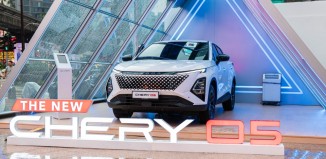Mercedes-Benz GLC – All-new C-Class-based crossover makes world debut
The large gap between the compact GLA and mid-sized M-Class in Mercedes-Benz’s SUV line-up will soon be plugged by the all-new GLC that has just made its global debut in Stuttgart. Under Merc’s newly-restructured SUV naming convention, the GLC is based on underpinnings of the W205 C-Class and replaces the GLK that was previously not offered in right-hand drive configuration. The same naming convention will see the M-Class transformed by the GLE.
A range of EU6 engines power the new GLC, amongst them a plug-in hybrid GLC 350 e 4Matic model with carbon dioxide emissions in the region of 60 g/km yet able to hit a top speed of 235kph. Supplementing outputs of 211hp from its 2.0-litre petrol engine with an additional 116hp from its electric drive, this variant is able to complete the century dash in 5.9 seconds and will cover 34km cruising in all-electric mode.

Conventional powertrains are drawn from Benz’s familiar range of turbocharged four-cylinder engines, all fitted with all-wheel drive and mated with Merc’s in-house 9-speed automatic transmission as standard. Petrol power is supplied by the ubiquitous 2.0-litre M274 generating its familiar numbers outputs of 211hp and 350Nm for the GLC 250 4Matic. It is able to achieve a top speed of 222kph and a 0-100kph time of 7.3 seconds, whilst consuming between 6.5 and 7.1 l/100km, corresponding to CO2 emissions of 152-166 g/km.
Diesel variants utilize the 2.1-litre OM651 in two states of tune – 170hp/400Nm powering the GLC 220 d 4Matic and 204hp/500Nm in the GLC 250 d 4Matic – both quoted with identical fuel consumption of 5.0-5.5 l/100km (CO2 – 129-143 g/km). Top speed and 0-100kph times read 210kph and 8.5 seconds for the 220 d and 222kph and 7.6 seconds for the 250 d. Compared with equivalent variants of the outgoing GLK, Mercedes claims improvements in efficiency to the tune of 12 percent for the petrol variant and 19 percent for the two diesels.
Despite measuring larger in size than the outgoing GLK and carrying more equipment, Mercedes-Benz claims that the GLC weighs in at 80kg lighter than its predecessor, thanks to extensive usage of aluminium and various high-strength and ultra-high-strength steels. The new 9G-Tronic transmission is encased in a lightweight magnesium housing with the 4Matic system’s transfer case built as an add-on module to the gearbox.
Standard suspension in all variants of the GLC consist of adaptive dampers with steel springs, the latter which can be optionally upgraded to air springs. For robust usage, customers have the option of additionally specifying the Off-Road Engineering Package in conjunction with air springs, enabling the latter to raise ride height by an extra 50mm for better ground clearance.
Trickled down from Mercedes’ stable of sedan models is an extensive range of active, passive, and autonomous safety and driving aids available in the GLC. Autonomous emergency braking, Crosswind Assist, active headlamps, and drowsiness detection are standard in all models. Optional upgrades include active cruise control with queue assist, cross-traffic assist, blind spot warning, lane keeping assist, pedestrian detection, and traffic sign recognition.


































